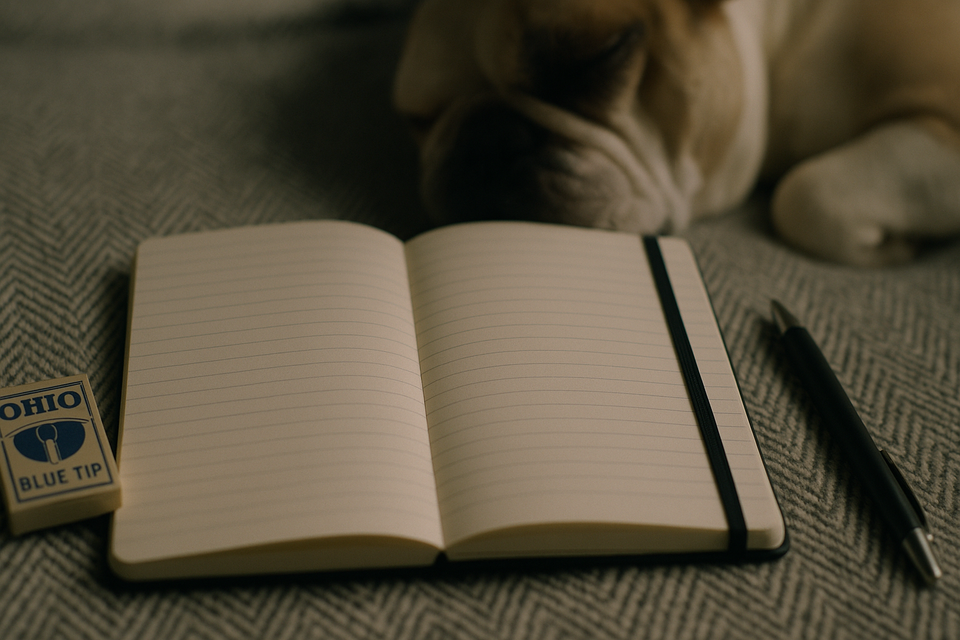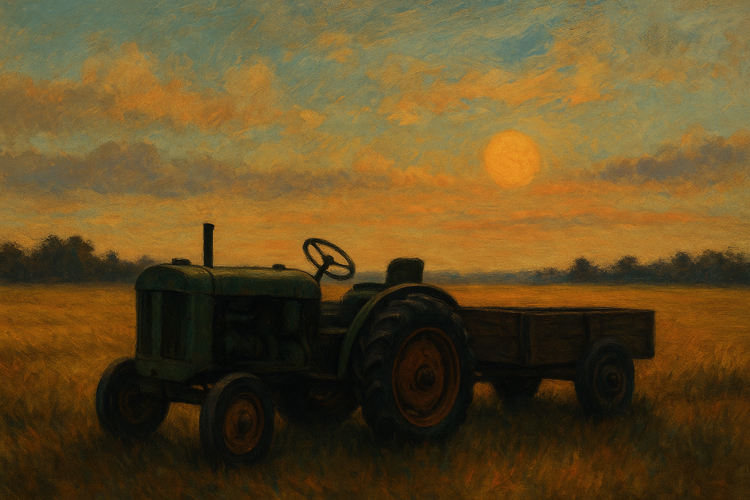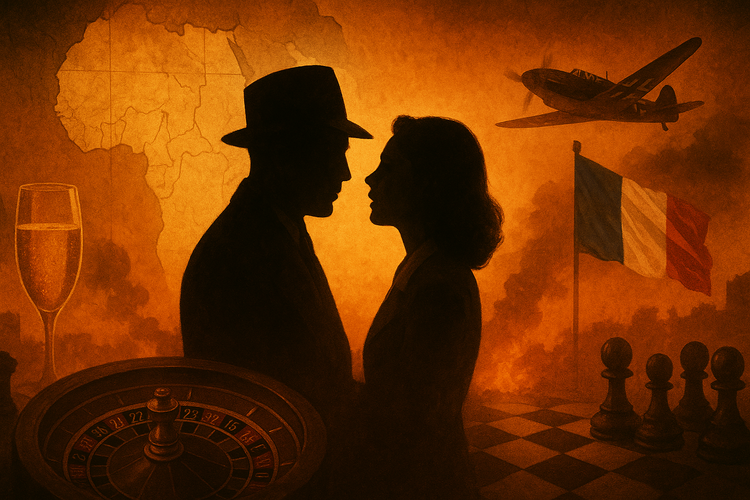Paterson (2016): Poems in the Pattern of Days

A Week Like Any Other
Jim Jarmusch’s Paterson (2016) begins not with spectacle or tension, but with two people in bed. The image is ordinary to the point of plainness — a couple waking together, no alarms, no grand events. Yet the calm is disarming. In this silence, with bodies half-folded into each other, the film establishes its register: comfort as subject, routine as rhythm. What follows is not drama in the conventional sense but a week’s worth of repetitions, small variations accumulating meaning. The sound of a spoon in coffee, the walk past a crooked mailbox, the quiet trudge to the depot — fragments repeat like lines in a poem, their resonance growing as the week advances. Where other films build toward confrontation, Paterson leans into the texture of daily life, asking us to notice how ordinary gestures can deepen when seen again and again.
The House, the Couple, the Dog
At the center is Adam Driver as Paterson, a bus driver whose very name ties him to the town he inhabits. Driver plays him without affectation; steady, almost impassive, yet never blank. His silences feel lived-in, the pauses of someone accustomed to listening more than speaking. Opposite him, Golshifteh Farahani brings Laura a buoyant energy that risks flightiness but never quite tips over. She is restless, full of projects — repainting curtains, baking cupcakes, dreaming of guitars — and her bursts of enthusiasm counterpoint Paterson’s quiet routine. Even Marvin, the bulldog with a perpetual scowl, registers as a character with his own will, dragging Paterson down the street each night and eventually committing an act of petty destruction that feels almost deliberate. Together they form a modest household that is fragile and comic, grounded in affection yet open to disruption.
The Cycle and the Poems
The film moves through Paterson’s week with the steadiness of his footsteps: breakfast, depot, bus route, overheard voices, the evening walk, the tilted mailbox. The cycle is not a trap; it is a pattern, and Jarmusch lingers on it as if routine itself were a canvas. Variations are small — a new overheard story, a fresh line of Laura’s dreams, a quiet exchange at the bar — yet together they accumulate into something larger than repetition.
Woven into this rhythm is Paterson’s poetry, scribbled in a small notebook during breaks at work or in the pauses before sleep. The verses are plainspoken, rooted in the details of his mornings — a box of Ohio Blue Tip matches, the shape of a word, the glow of a moment barely worth remarking. They are not staged as masterpieces, nor framed as revelations. Instead, writing itself becomes part of the day’s fabric, as natural as tying shoes or walking the dog. What matters is not the finished poem but the attention it represents: the way Paterson notices what most of us let slip by, and gives it shape. His art grows out of the ordinariness of his life, not as escape but as deepening.
Laura and the Dream of Twins
If Paterson’s days move in measured lines, Laura’s spill outward in curves. She remakes their little house into a patchwork of black-and-white patterns, bakes cupcakes, orders a guitar online. She dreams with abandon, sketching futures for herself that range from country music to culinary fame. For Paterson, her impulses are both baffling and endearing; he hesitates at the cost of the guitar, winces at her brussels sprout pie, yet meets her excitement with steady support. If his poetry grows from quiet attention, hers takes the form of exuberant invention. Their balance of restraint and excess is tested when Laura dreams of giving birth to twins, a seed that grows into one of the film’s strangest motifs: pairs of twins appearing again and again as the week unfolds, echoing something just beneath the surface.
Twins, Doubles, and the City as Character
Once the dream is spoken, twins surface everywhere: on sidewalks, in the back of the bus, in the figure of a girl who reads Paterson one of her own poems. The motif never explains itself, but lingers with weight. Is Paterson a twin to his city, carrying its name as both burden and reflection? Is each repeated day a doubling of the last, slightly altered but essentially the same? Paterson, New Jersey is not backdrop but a character of faded walls and remembered histories — murals ghosting from brick, news clippings on bar walls, a landscape where past and present overlap. The doubled figures feel less like coincidence than echoes, reminders that every life is shadowed by another, every street layered with reflection.
Verses from Other Lives
Around this central rhythm, Jarmusch threads encounters that feel like verses drifting in from other poems: Everett unraveling over a lost love, the bartender playing nightly chess against himself, a rapper rehearsing rhymes in a laundromat. These fragments never build toward climax — they pass in and out of Paterson’s week like stanzas, giving shape to the sense that every life in the town carries its own rhythm, whether anguished, absurd, or quietly creative. None are staged as revelation, yet each carries a flicker of creation or performance. In Paterson’s world, art is not elevated above life but threaded through it, arising in bars and kitchens, in buses and on sidewalks. The film’s gentlest insistence is that making art is less about genius than attention — the willingness to notice, to give form to passing experience, and to let it echo.
Marvin and the Breaking of the Pattern
For all the patience and small comforts of the week, the sharpest rupture comes from Marvin, the sullen bulldog who nurses a quiet grudge. One evening, when Paterson forgets to put his notebook away, Marvin acts: the pages are shredded, not just the week’s scribbles but the accumulation of years. The loss is devastating, erasing the fragile record of a private life. Yet Paterson does not rage or collapse. He mutters only, “I don’t like you, Marvin,” a line of deadpan humor masking grief. In a film so attuned to repetition, the destruction of the notebook feels like the sudden breaking of a pattern, the silence heavier than any argument.
The Falls and a New Notebook
In the aftermath, Paterson walks to the Great Falls, the place where he takes lunch each day, now less backdrop than reckoning. On a bench he meets a Japanese visitor who recognizes the city’s poetic lineage and carries with him William Carlos Williams’ Paterson. Their conversation is quiet, respectful, tilting the film toward renewal. The stranger tells him, “I breathe poetry,” and offers a blank notebook as a gift. It is not compensation, nor solution, but an invitation to begin again — to see that even silence after destruction can be given shape.
The film closes where it began: Paterson waking beside Laura on a Monday morning. The week has turned over, the rhythm renewed. We do not follow him to the depot or onto the bus; the rest is implied. What matters is the gesture itself — the rising, the quiet acceptance that another week will unfold. The loss still hangs, but the blank notebook rests ready. In ending with this return to routine, Jarmusch offers neither climax nor closure, only the reassurance that beginnings are always folded inside repetition.
Flaws and Risks
For all its quiet grace, Paterson carries risks that will not sit evenly with every viewer. Laura, in particular, can feel elusive. Her bursts of energy — cupcakes, curtains, guitars, Persian daydreams — bring levity to the house, yet they flirt with eccentricity for its own sake. She remains harder to read than Paterson, more emblem than character, and that imbalance risks tipping her into quirk rather than depth. The pacing, too, may test patience. Jarmusch lingers on bus rides, sidewalks, and slow walks with Marvin until the line between poetic attention and monotony grows thin. Even the twin motif, so insistently present, never resolves; it hovers as suggestion without explanation, a mystery some may find rich and others unfinished. None of these are failings exactly, but they reveal how narrowly the film walks its line — a portrait of ordinary life that could easily collapse into tedium or whimsy if one’s attention falters.
Verdict
Paterson begins and ends in the same bed, two bodies rising into the rhythm of another day. What happens in between is small, fragile, sometimes frustrating, but shaped with enough patience to reveal its quiet beauty. Jarmusch resists climax, explanation, even resolution, offering instead a meditation on routine and attention. Not every choice works — Laura remains hard to pin down, the pacing can drift — yet the film succeeds more often than it stumbles. Like the poems scribbled in Paterson’s notebook, it finds meaning in the ordinary and asks us to notice what repetition makes visible. On balance, it is recommended; a steady, unshowy work that earns its place. Three and a half stars.



Comments ()